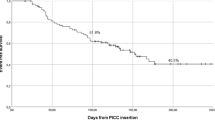Abstract
Background
In contrast to the high risk of haemorrhage associated with the implantation of a central venous catheter (CVC) via the internal jugular or subclavian access, the use of a peripherally inserted catheter (PICC) offers the advantage of a lower risk of bleeding complications. However, the rate of phlebitis is higher with the PICC and its use has been declining. We have studied the benefits and adverse events of a new type of PICC and a common type.
Methods
From October 1999 to October 2001, 70 PICCs (Olimpicc, Vygon, Germany, n=40; and LIFECATH-PICC(PUR)5FR Vygon, Germany, n=30) were inserted into 66 patients with haematological malignancies and used for high-dose chemotherapy, total parenteral nutrition and autologous blood stem cell transplantation. While removing the catheter, central and peripheral blood cultures were taken. The catheter tip was investigated by the semi-quantitative roll-out method of Maki.
Results
Sixty-five PICCs were removed after a median of 8.9 days. In five cases a catheter-associated significant colonisation with coagulase-negative staphylococci occurred. In two instances catheter-related bacteraemia was found.
Conclusion
In our study this catheter system was inserted in 94% of patients without problems and showed a low incidence of phlebitis (5/65). Because of the high rate of catheter malfunction reported during and after our study, the Olimpicc catheter is no longer available. The PICC system, and the LIFECATH-PICC(PUR)5FR in particular, offers a safe and effective alternative for central venous access to the internal jugular vein.
Similar content being viewed by others
References
Allen AW, Megargell JL, Brown DB, Lynch FC, Singh H, Singh Y, Waybill PN (2000) Venous thrombosis associated with the placement of peripherally inserted central catheters. J Vasc Interv Radiol 11(10):1309–1314
Black IH, Blosser SA, Murray WB (1999) Clinical factors associated with the development of phlebitis after insertion of a peripherally inserted central catheter. Nurs 22:36–42
Black IH, Blosser SA, Murray WB (2000) Central venous pressure measurements: peripherally inserted catheters versus centrally inserted catheters. Crit Care Med 28:3833–3836
Bottino J, McCredie KB, Groschel DH, Lawson M (1979) Long-term intravenous therapy with peripherally inserted silicone elastomer central venous catheters in patients with malignant diseases. Cancer 43(5):1937–1943
Cardella JF, Cardella K, Bacci N, Fox PS, Post JH (1996) Cumulative experience with 1,273 peripherally inserted central catheters at a single institution. J Vasc Interv Radiol 7:5–13
Dolcourt JL, Bose CL (1980) Percutaneous insertion of silastic central venous catheters in newborn. Pediatrics 70:484–486
Giuffrida DJ, Bryan-Brown CW, Lumb PD, Kwun KB, Rhoades HM (1986) Central vs peripheral venous catheters in critically ill patients. Chest 90(6):806–809
Grove JR, Pevec WC (2000) Venous thrombosis related to peripherally inserted central catheters. J Vasc Interv Radiol 11(7):837–840
Kyle SK, Myers JS (1990) Peripherally inserted central catheters: Development of a hospital based program. J Intraven Nurs 13:287–290
Maki DG, Weise CE, Sarafin HW (1977) A semiquantitative culture method for identifying intravenous catheter related infection. N Engl J Med 296:1305–1309
Markel S, Reynen K (1990) Impact on patient care: 2652 PIC catheter days in the alternative setting. J Intraven Nurs 13:347–351
Merrell SW, Peatross BG, Grossman MD, et al (1994) Peripherally inserted central venous catheters: low-risk alternatives for ongoing venous access. West J Med 160:125–130
Ng PK, Ault MJ, Ellrodt AG, Maldonado L (1997) Peripherally inserted central catheters in general medicine. Mayo Clin Proc 72:225–233
Paz-Fumagalli R, Miller YA, Russell BA, Crain MR, Beres RA, Mewissen MW (1997) Impact of peripherally inserted central catheters on phlebitic complications of peripheral intravenous therapy in spinal cord injury patients. J Spinal Cord Med 20(3):341–344
Puntis JWL (1986) Percutaneous insertion of central venous feeding catheters. Arch Dis Child 61:1138–1140
Shaw JCL (1973) Parenteral nutrition in the management of sick low birthweight infants. In: Gluck L (ed) Pediatr Clin North Am Saunders, Philadelphia, 20:333–358
Sheppard R, Ong TH (1980) Evaluation of percutaneously inserted peripheral silicone catheters for parental nutrition in infants and children. Aust Paediatr J 16:181–184
Sherertz et al (1997) The risk of peripheral vein phlebitis associated with chlorhexidin-coated catheters: a randomized, double-blind trial. Infect Control Hosp Epidemiol 18:230–236
Smith JR, Friedell ML, Cheatham ML, Martin SP, Cohen MJ, Horowitz JD (1998) Peripherally inserted central catheters revisited Am J Surg 176(2):208–211
Sweed M, Guenter P, Lucente K, Turner JL, Weingarten MS (1995) Long-term central venous catheters in patients with acquired immunodeficiency syndrome. Am J Infect Control 23(3):194–199
Williams J, Smith HL, Woods CG, Weller PH (1988) Silastic catheters for antibiotics in cystic fibrosis. Arch Dis Child 63:658–659
Author information
Authors and Affiliations
Corresponding author
Rights and permissions
About this article
Cite this article
Harter, C., Ostendorf, T., Bach, A. et al. Peripherally inserted central venous catheters for autologous blood progenitor cell transplantation in patients with haematological malignancies. Support Care Cancer 11, 790–794 (2003). https://doi.org/10.1007/s00520-003-0517-x
Received:
Accepted:
Published:
Issue Date:
DOI: https://doi.org/10.1007/s00520-003-0517-x




